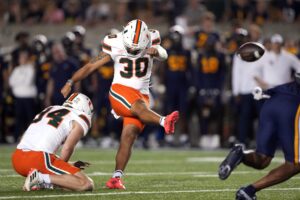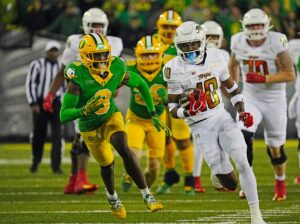Reimagining NIL Compensation
Here at Last Word on College Football, we have been ahead of the curve on the myriad of changes to college football over the last decade. Instead of simply reporting on breaking events that made the name, image, and likeness (NIL) compensation appear imminent, we chose to dig deeper. Instead of simply observing changes to the landscape, we evaluated how it might play out. Rather than complaining about the transfer portal’s effects, we reimagined how it might look in the future to level the playing field. Currently, inconsistent patchwork state laws govern the bounds of NIL compensation. Serious questions we asked early still fail to find answers. As a result, we take a look here at reimagining NIL compensation in the broader scheme of college football.
How Rich Will the Rich Get?
One of the biggest problems with NIL compensation, in our view, centers around a simple concern: will the rich just get richer? We have now seen a full recruiting cycle impacted by NIL. While it is still too early to draw any long-term conclusions, a few things jump out looking at the numbers. In 2020, 18 different schools pulled double-digit blue-chip recruits. By 2022, that number decreased to 14, a reduction of 23%. On the other hand, in 2020 seven schools brought in two or more five-star recruits. In 2022, that number increased to 8. Additionally, while 2018 produced just one class with 20 blue chips, 2022 saw 4 different schools hit that mark.
2022 also saw two new entrants into the top five recruiting classes: Texas A&M and Texas. For those who want to see college football championships featuring teams other than Alabama, Clemson, Georgia, Ohio State, and LSU, the 2022 recruiting results show promise. Thus, while the schools with passionate and rich alumni bases may pull off historic recruiting years (like the Aggies did this year), we may well see more schools make top five and top ten appearances more often.
Unfortunately, this may come at the expense of schools with smaller or less affluent alumni bases. If Texas A&M requires tens of millions of dollars to pull in a whopping 27 blue-chip recruits, how can schools like Vanderbilt, Indiana, Virginia Tech, or West Virginia (who already have total revenues that are less than half the richest ten schools) possibly keep up? That is a very real question.
Does Competitive Balance Matter to Anyone?
The next question stems directly from the prior? Does it actually matter if smaller budget schools cannot keep up? Will anybody other than the fans of those particular schools lose sleep? Does anyone care if the Pittsburgh Pirates or Cleveland Guardians spend roughly a quarter of the New York Yankees, Los Angeles Angels, or Houston Astros?
We would like to think that the nature of college athletics means that most fans do have a vested interest in seeing the cinderellas emerge across all major sports, including football. They may not end up winning the national championship, but seeing those teams win 10 games and come out in a big bowl with something to prove make college football interesting.
That said, blue blood predictably manipulates most of the rules–or lack thereof–in their favor. Economics and capital rule the world, and, with how much money the NCAA, conferences, schools, and media markets make from the game, the simple fact is that those who have the most money will spend the most money.
Will NIL Actually Disrupt that Balance?
Perhaps a better question is this: will inequalities in the level of talent actually disrupt competitive balance? Even if the top 10 schools each year spend to load their classes with blue-chip talent, they still have just 25 scholarships per year to give (unless the NCAA further expands the current single-year cap designed to allow teams to replace transfers). Ten schools might grab 200 blue chips, but there are still 200 left each year.
Honestly, that is how things shake out presently. Five to ten teams compete for the coveted top-five recruiting class rankings. Another 20 to 25 schools compete to fill out the 10-30 spots on that list. Competition between those schools remains fierce, both on the field and off. Whether NIL will further concentrate that talent to the top remains to be seen.
Some Regulations Still Make Sense
That said, regulations still make sense here. Readers who respond “NIL is bad and should be removed” can stop here. It is not leaving. It is now a part of college athletics’ DNA going forward. Fans can, of course, choose to keep watching or not.
Where we are today, though, is a weird place. The NCAA has a few “rules” about NIL. They at least say that NIL cannot be a “pay-for-play” system and that schools cannot use NIL to induce recruits to attend certain schools. Clearly, though, they are not enforcing those rules, and colleges are definitely crossing that line with the blessing of patchwork state legislation that changes by the month.
Uniformity in When Players Can Be Paid
So what regulations make sense? First, when reimagining NIL compensation, we crave uniformity in rules governing when players can earn NIL money. Some players have enrolled in schools just because those states allow players to earn NIL money while still in high school. Other players have spurned certain schools (and ultimately transferred to those schools) for the opposite reason: because they had deals on the table and could not get paid. Players universally should either have the freedom to get paid as soon as they sign a letter of intent, or they should universally have the limitation that they cannot get paid until they enroll in their new school. Treating one player differently in this regard because of where he currently lives defies rationality.
Uniformity in School Involvement
Second, in reimagining NIL compensation, we prefer uniformity in the extent to which schools themselves can obtain or negotiate NIL deals. Some states allow (impliedly, anyway) schools and their biggest boosters to involve themselves in such deals. Other states have express bars on that involvement.
As a result, players must currently navigate patchwork laws that “experts” are just now starting to understand fully while still in high school and balancing the other factors that cause them to make decisions. Schools, meanwhile, have competitive advantages or disadvantages based on what their state politicians feel is or is not appropriate. This–perhaps more than the mechanism of NIL itself–may disrupt the competitive balance of the game.
We leave alone, for now, the substance of these questions. We do, however, feel strongly that uniformity in this regard would help.
Unfortunately, the only way to foresee such uniformity is through the federal government. Given the NCAA’s limited power and willingness to exercise what questionable power it has left, it will literally take an act of Congress to inject uniformity here. Rightfully so, Congress probably has more important things to worry about.






